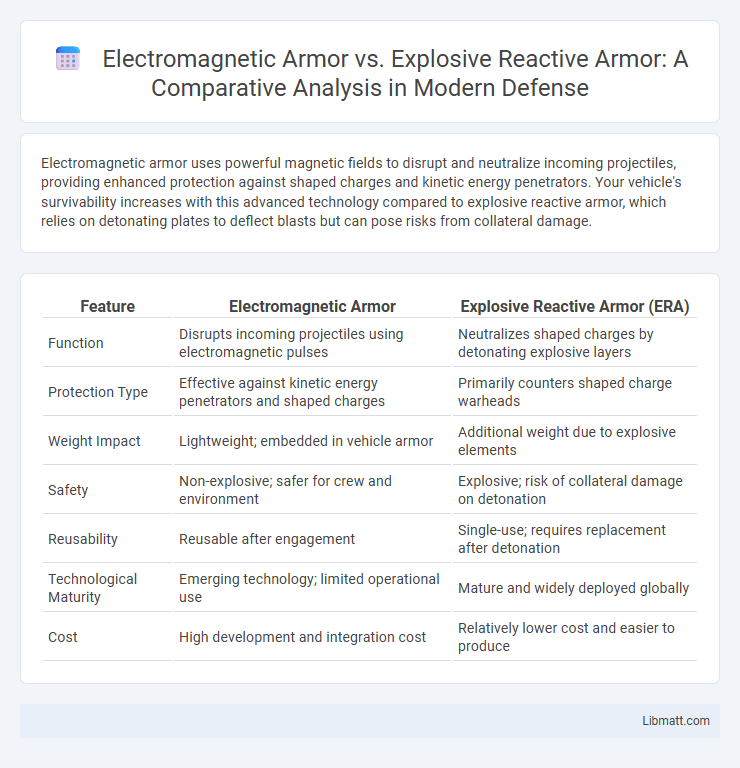Electromagnetic armor uses powerful magnetic fields to disrupt and neutralize incoming projectiles, providing enhanced protection against shaped charges and kinetic energy penetrators. Your vehicle's survivability increases with this advanced technology compared to explosive reactive armor, which relies on detonating plates to deflect blasts but can pose risks from collateral damage.
Table of Comparison
| Feature | Electromagnetic Armor | Explosive Reactive Armor (ERA) |
|---|---|---|
| Function | Disrupts incoming projectiles using electromagnetic pulses | Neutralizes shaped charges by detonating explosive layers |
| Protection Type | Effective against kinetic energy penetrators and shaped charges | Primarily counters shaped charge warheads |
| Weight Impact | Lightweight; embedded in vehicle armor | Additional weight due to explosive elements |
| Safety | Non-explosive; safer for crew and environment | Explosive; risk of collateral damage on detonation |
| Reusability | Reusable after engagement | Single-use; requires replacement after detonation |
| Technological Maturity | Emerging technology; limited operational use | Mature and widely deployed globally |
| Cost | High development and integration cost | Relatively lower cost and easier to produce |
Introduction to Modern Armor Technologies
Electromagnetic armor uses powerful electric currents to generate a magnetic field that disrupts or neutralizes incoming projectiles, enhancing protection against shaped charges and kinetic energy penetrators. Explosive reactive armor consists of explosive-filled tiles that detonate upon impact, counteracting incoming threats by disrupting their penetration effect. Your choice between these advanced protective technologies depends on the specific threat environment and the vehicle's operational requirements.
Fundamentals of Electromagnetic Armor
Electromagnetic armor utilizes powerful magnetic fields generated by high-capacity capacitors to disrupt and neutralize incoming kinetic energy penetrators or shaped charge jets before impact. This armor system relies on rapid electromagnetic pulses to induce currents in the projectile, causing deformation or deflection, thereby enhancing vehicle survivability. Unlike Explosive Reactive Armor, which uses chemical explosions to counter threats, electromagnetic armor offers reusable, non-explosive protection with faster response times and reduced collateral damage.
Principles of Explosive Reactive Armor
Explosive Reactive Armor (ERA) functions by detonating a thin layer of explosive material sandwiched between metal plates upon impact from a shaped charge or kinetic energy penetrator, disrupting the attack jet and reducing penetration effectiveness. This reactive response alters the trajectory and energy of the incoming projectile, offering enhanced protection for armored vehicles against anti-tank weapons. ERA differs from electromagnetic armor by relying on controlled explosions to counteract threats rather than using electromagnetic fields to disrupt penetrators.
Technical Comparison: Electromagnetic vs Explosive Reactive Armor
Electromagnetic armor uses powerful magnetic fields to disrupt and deflect incoming projectiles, offering rapid response and reusability compared to Explosive Reactive Armor (ERA), which relies on chemical explosions to neutralize threats. ERA consists of explosive-filled plates that detonate upon impact, effectively countering shaped charges but risking collateral damage and requiring replacement after activation. Your choice between electromagnetic and explosive reactive armor depends on factors like operational environment, threat type, and vehicle design constraints.
Effectiveness Against Contemporary Munitions
Electromagnetic armor employs strong magnetic fields to disrupt the path of metallic penetrators and shaped charges, offering enhanced protection against kinetic energy penetrators and tandem-charge warheads commonly used in modern anti-tank munitions. Explosive reactive armor (ERA) counters shaped charges by detonating upon impact, disrupting the penetrator jet, but is less effective against multiple hits and kinetic projectiles like armor-piercing fin-stabilized discarding sabot (APFSDS) rounds. Your choice of armor technology should consider threat profiles, with electromagnetic armor providing superior defense against high-velocity and advanced tandem munitions.
Durability and Maintenance Requirements
Electromagnetic armor offers superior durability due to its non-mechanical design, reducing wear and tear compared to Explosive Reactive Armor (ERA), which relies on explosive plates that degrade with each hit. Maintenance for electromagnetic armor is relatively minimal, mainly involving electronic system checks, whereas ERA requires careful replacement of spent explosive elements, increasing downtime and logistical complexity. Your choice between the two should consider the lifecycle support infrastructure, as electromagnetic armor provides long-term reliability with less frequent maintenance demands.
Implementation Challenges and Limitations
Electromagnetic armor requires complex power supply systems and advanced electromagnetic pulse control, posing significant integration and reliability challenges in field conditions. Explosive reactive armor faces limitations due to collateral damage risk, weight increase, and reduced effectiveness against tandem warheads in modern anti-tank weaponry. Both armor types must balance protection efficacy with vehicle mobility constraints and maintenance demands under combat stress.
Safety Considerations for Military Personnel
Electromagnetic armor enhances safety for military personnel by neutralizing incoming projectiles with electrical pulses, minimizing the risk of detonations near troops. Explosive reactive armor poses safety challenges due to its reliance on controlled explosions upon impact, which can endanger nearby soldiers through shrapnel and blast damage. The non-kinetic nature of electromagnetic armor reduces collateral hazards, making it a safer alternative in close-combat scenarios.
Cost and Logistics Analysis
Electromagnetic armor demands significant investment in advanced power systems and specialized maintenance, increasing overall logistical complexity compared to explosive reactive armor (ERA), which relies on simpler, modular explosive plates. ERA offers cost-effective production and ease of replacement in the field but raises safety concerns during transport and handling due to its volatile nature. Your choice between these armor types should weigh the long-term operational expenses and supply chain challenges against mission-specific threat environments.
Future Trends in Vehicle Armor Development
Electromagnetic armor leverages high-velocity plasma jets generated by magnetic fields to neutralize incoming projectiles, offering rapid response and minimized collateral damage compared to traditional Explosive Reactive Armor (ERA), which uses controlled detonations to disrupt shaped charges. Future trends indicate a shift towards integrating electromagnetic systems with advanced sensors and AI-driven targeting to enhance adaptability against evolving threats such as tandem warheads and kinetic energy penetrators. Research also emphasizes lightweight materials and energy-efficient power sources to improve vehicle mobility and operational endurance while maintaining superior protective capabilities.
Electromagnetic armor vs Explosive reactive armor Infographic

 libmatt.com
libmatt.com